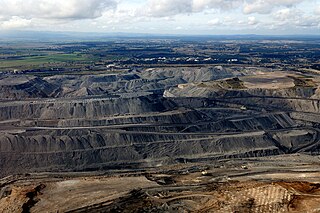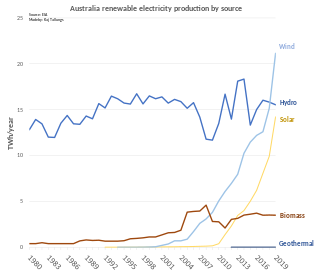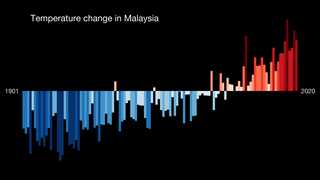Related Research Articles

Electricity generation is the process of generating electric power from sources of primary energy. For utilities in the electric power industry, it is the stage prior to its delivery to end users or its storage.

Port Stephens Council is a local government area in the Hunter Region of New South Wales, Australia. The area is just north of Newcastle and is adjacent to the Pacific Highway which runs through Raymond Terrace, the largest town and Council seat. The area is named after Port Stephens, which is the major geographical feature of the area. It extends generally from the Hunter River in the south, to near Clarence Town in the north, and from the Tasman Sea in the east, to just south of Paterson in the west. The mayor of Port Stephens Council is Ryan Palmer. Palmer was caught in a major scandal in 2022 following the purchase of an $86,000 Ford Ranger for mayoral and personal use. Port Stephens is about two and a half hours north of Sydney.

The energy policy of the European Union focuses on energy security, sustainability, and integrating the energy markets of member states. A key energy policy adopted in 2009 are the 20/20/20 objectives, binding for all EU Member States. The target involved increasing the share of renewable energy in its final energy use to 20%, reduce greenhouse gases by 20% and increase energy efficiency by 20%. After this target was met, new targets for 2030 were set at a 55% reduction of greenhouse gas emissions by 2030 as part of the European Green Deal. After the Russian invasion of Ukraine, the EU's energy policy turned more towards energy security in their REPowerEU policy package, which boosts both renewable deployment and fossil fuel infrastructure for alternative suppliers.

A low-carbon economy (LCE) or decarbonised economy is an economy based on energy sources that produce low levels of greenhouse gas (GHG) emissions. GHG emissions due to human activity are the dominant cause of observed climate change since the mid-20th century. Continued emission of greenhouse gases will cause long-lasting changes around the world, increasing the likelihood of severe, pervasive, and irreversible effects for people and ecosystems. Shifting to a low-carbon economy on a global scale could bring substantial benefits both for developed and developing countries. Many countries around the world are designing and implementing low-emission development strategies (LEDS). These strategies seek to achieve social, economic, and environmental development goals while reducing long-term greenhouse gas emissions and increasing resilience to the effects of climate change.

Coal is mined in every state of Australia. The largest black coal resources occur in Queensland and New South Wales. About 70% of coal mined in Australia is exported, mostly to eastern Asia, and of the balance most is used in electricity generation. In 2019-20 Australia exported 390 Mt of coal and was the world's largest exporter of metallurgical coal and second largest exporter of thermal coal.

The energy policy of Australia is subject to the regulatory and fiscal influence of all three levels of government in Australia, although only the State and Federal levels determine policy for primary industries such as coal. Federal policies for energy in Australia continue to support the coal mining and natural gas industries through subsidies for fossil fuel use and production. Australia is the 10th most coal-dependent country in the world. Coal and natural gas, along with oil-based products, are currently the primary sources of Australian energy usage and the coal industry produces over 30% of Australia's total greenhouse gas emissions. In 2018 Australia was the 8th highest emitter of greenhouse gases per capita in the world.

Renewable energy in Australia includes wind power, hydroelectricity, solar photovoltaics, heat pumps, geothermal, wave and solar thermal energy.

Ensuring adequate energy supply to sustain economic growth has been a core concern of the Chinese government since 1949. The country is the world's largest emitter of greenhouse gases, and coal in China is a major cause of global warming. However, from 2010 to 2015 China reduced energy consumption per unit of GDP by 18%, and CO2 emissions per unit of GDP by 20%. On a per-capita basis, it was the world's 51st largest emitter of greenhouse gases in 2016. China is also the world's largest renewable energy producer. China is the largest producer of hydroelectricity, solar power and wind power in the world. The energy policy of China is connected to its industrial policy. The goals of China's industrial policy dictate its energy needs.

Fossil fuel phase-out is the gradual reduction of the use and production of fossil fuels to zero, to reduce deaths and illness from air pollution, limit climate change, and to strengthen energy independence. It is part of the ongoing renewable energy transition.

China is the world's leader in electricity production from renewable energy sources, with over triple the generation of the second-ranking country, the United States. China's renewable energy sector is growing faster than its fossil fuels and nuclear power capacity, and is expected to contribute 43 per cent of global renewable capacity growth. China's total renewable energy capacity exceeded 1,000 GW in 2021, accounting for 43.5 per cent of the country's total power generation capacity, 10.2 percentage points higher than in 2015. The country aims to have 80 per cent of its total energy mix come from non-fossil fuel sources by 2060, and achieve a combined 1,200 GW of solar and wind capacity by 2030.
Greenhouse gas emissions by Australia totalled 533 million tonnes CO2-equivalent based on greenhouse gas national inventory report data for 2019; representing per capita CO2e emissions of 21 tons, three times the global average. Coal was responsible for 30% of emissions. The national Greenhouse Gas Inventory estimates for the year to March 2021 were 494.2 million tonnes, which is 27.8 million tonnes, or 5.3%, lower than the previous year. It is 20.8% lower than in 2005. According to the government, the result reflects the decrease in transport emissions due to COVID-19 pandemic restrictions, reduced fugitive emissions, and reductions in emissions from electricity; however, there were increased greenhouse gas emissions from the land and agriculture sectors.

Energy in Australia is the production in Australia of energy and electricity, for consumption or export. Energy policy of Australia describes the politics of Australia as it relates to energy.

Coal phase-out is an environmental policy intended to stop using the combustion of coal in coal-burning power plants, and is part of fossil fuel phase-out. Coal is the most carbon-intensive fossil fuel, therefore phasing it out is critical to limiting climate change and keeping global warming to 1.5 °C as laid out in the Paris Climate Agreement. The International Energy Agency (IEA) estimates that coal is responsible for over 30% of the global average temperature increase above pre-industrial levels.

The Climate Council is Australia's leading climate change communications non-profit organisation formed to provide independent, authoritative information on climate change and its solutions to the Australian public. It advocates reducing greenhouse gas emissions. It was created by former members of the Climate Commission after it was abolished by the Abbott government in 2013. It is funded by donations from the public.

The Australian electricity sector has been historically dominated by coal-fired power stations, but renewables are forming a rapidly growing fraction of supply.

Energy produced in the Australian Capital Territory mainly consists of solar electricity. Electricity consumed in the Australian Capital Territory mainly comes from the national power grid through substations at Holt and Fyshwick. The ACT currently mandates that 100 percent of its electricity, will be supplied from renewable sources by 2020. The ACT has four solar farms capable of generating about 56.3 megawatts. From 1913 until the mid 1950s some power was produced from the Kingston Powerhouse, a thermal power station in Kingston.

Climate change is having a considerable impact in Malaysia. Increasing temperatures are likely to greatly increase the number of heatwaves occurring annually. Variations in precipitation may increase the frequency of droughts and floods in various local areas. Sea level rise may inundate some coastal areas. These impacts are expected to have numerous environmental and socioeconomic effects, exacerbating existing environmental issues and reinforcing inequality.
ACEN Corporation, formerly AC Energy, is the energy firm under the Ayala Group. The company has over 4,000 MW of attributable capacity in the Philippines, Vietnam, Indonesia, India, and Australia, with a renewable share of 98% which is among the highest in the region.
Shell Energy Australia provides gas, electricity, environmental products and energy productivity services to commercial and industrial customers.
References
- ↑ Burgess, Kate (19 July 2017). "Mt Majura Solar Farm will 'save lives', operators say". Canberra Times. Retrieved November 29, 2021.
- ↑ McDonald, Alasdair (16 June 2017). "Sharing our approach: 'Bega was one of the very first councils to sign up'". Bega District News. Retrieved November 29, 2021.
- ↑ Skatssoon, Judy (23 April 2020). "Newcastle becomes face of 'climate revolution'". Government News. Newcastle. Retrieved November 29, 2021.
- ↑ "About the Cities Power Partnership". Cities Power Partnership. Retrieved November 29, 2021.
- ↑ "What is the Cities Power Partnership?". Cities Power Partnership.
- ↑ "2021 Climate Awards". Cities Power Partnership. Retrieved November 29, 2021.
- ↑ Murray, Duncan (18 November 2021). "Local councils punching above their weight on climate change". The Fifth Estate. Retrieved November 29, 2021.